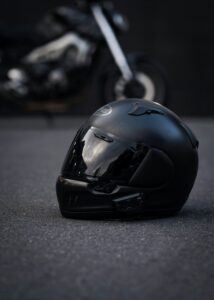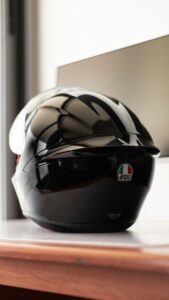

Must-Know Tips for Choosing the Perfect Motorcycle Helmet:
Essential Tips for Choosing the Best Motorcycle Helmet: What You Need to Know About Safety Ratings, Types, and More:
When it comes to motorcycle safety, one of the most crucial pieces of gear is the helmet. A high-quality helmet can make the difference between a minor injury and a serious one. With so many options on the market, choosing the right helmet can be overwhelming. This guide will help you navigate through the key factors to consider, ensuring you make an informed decision.
1. Motorcycle Helmet Safety Ratings and Standards:
Before diving into the specifics of helmet types and features, it’s important to understand motorcycle helmet safety ratings. Helmets are designed to meet certain safety criteria, and it’s essential to choose one that adheres to these standards:
DOT (Department of Transportation): A standard set by the U.S. government that ensures helmets meet basic safety requirements.
ECE (Economic Commission for Europe): An international standard that is widely recognized and generally considered to be more rigorous than DOT.
Snell: An independent certification that goes beyond DOT and ECE standards, often used by racing enthusiasts.
ISI (Indian Standards Institute): A certification specific to India that ensures helmets meet local safety standards.
Always look for helmets that are certified by these organizations to ensure maximum protection. ISI certified motorcycle helmets are particularly important for riders in India.
2. Helmet Types:
Motorcycle helmets come in various types, each designed for specific riding styles and preferences:
-Full-Face Helmets: Offer the most protection by covering the entire head and face. Ideal for road riders and those seeking comprehensive safety.
- Pros: Maximum protection for the head and face, reduced wind and noise, better protection in a crash.
- Cons: Can feel heavy and may cause discomfort during long rides or in hot weather.
-Modular Helmets: Combine features of full-face and open-face helmets. They have a hinged chin bar that can be lifted, making them versatile for commuting.
- Pros: Versatile with the option to lift the chin bar, good for commuting and convenience, offers decent protection.
- Cons: The complex design can lead to potential weak points in safety, and in case of an accident or crash, the liftable chin bar may break or open unexpectedly.
-Adventure Helmets: Designed for off-road and long-distance riding, these helmets combine features of full-face and off-road helmets.
- Pros: Versatile for both on-road and off-road riding, usually equipped with a peak visor to reduce glare, good ventilation and comfort for long rides.
- Cons: Can be bulky and may not offer as much aerodynamic efficiency on highways, and the peak visor can catch wind.
-Half Helmets: Cover only the top of the head. They are lightweight and provide minimal coverage, usually favored by cruiser riders who prioritize style over safety.
- Pros: Extremely lightweight, great for style and minimalistic design, good for short, casual rides.
- Cons: Offer minimal protection and are not ideal for high-speed riding or severe impacts.
3. Material and Construction:
The material and construction of a helmet are vital for safety and durability:
-Outer Shell:
- Fiberglass: Provides strength and is relatively lightweight. Ideal for high-end helmets due to its durability.
- Polycarbonate: Common in budget-friendly helmets. It offers decent impact resistance but is heavier.
- Composite Blends: Combines materials like carbon fiber and Kevlar to balance strength, weight, and flexibility, often found in premium helmets.
- Carbon Fiber Outer Shell: Extremely strong and lightweight, providing superior protection while reducing helmet weight. Carbon fiber motorcycle helmets are often used in high-performance and racing helmets due to their excellent impact resistance and rigidity.
-Inner Liner:
- EPS Foam: This material absorbs impact energy and reduces the force transferred to your head. Multi-density EPS liners offer enhanced protection by using different foam densities in various areas.
- Removable Liners: Many helmets feature liners that can be removed and washed, which helps with hygiene and comfort.
-Shell Construction:
- Injection Molding: The most common method, providing durability and precise design.
- Hand-Laid Layers: Used in high-end helmets for better strength and lighter weight.
Additional features like emergency release systems and integrated chin guards can also enhance safety and convenience.
4. Fit and Comfort:
A helmet that fits well is crucial for both safety and comfort. Here’s how to ensure you get the right fit:
Measure Your Head: Use a tape measure to find the circumference of your head just above your eyebrows. For detailed instructions, visit our page on how to measure your head helmet size. Compare this measurement with the helmet size chart provided by the manufacturer.
Try It On: The helmet should fit snugly without any pressure points. It should not move excessively when you shake your head.Padding and Linings: Check the interior padding for comfort. Many helmets come with removable and washable liners for hygiene and adjustability.
5. Helmet Straps:
The strap system on a helmet is crucial for securing it properly. There are two main types:
-Quick Release Straps:
- Pros: Easy to fasten and unfasten, convenient for everyday use and quick adjustments.
- Cons: May not offer the same level of security as double-D ring straps, can be less durable over time.
-Double-D Ring Straps:
- Pros: Provides a secure and adjustable fit, commonly used in high-end helmets, mandatory in race tracks, known for durability and safety.
- Cons: Can be more time-consuming to fasten and unfasten, may require more effort to adjust.
6. Visibility and Additional Features;
Enhanced visibility and extra features can add convenience and safety:
-Visor: Choose a helmet with a clear, scratch-resistant visor. Consider helmets with tinted visors for sunny conditions and anti-fog coatings for better visibility.
-Communication Systems: Some helmets are equipped with built-in communication systems for hands-free phone calls and GPS directions.
7. Ventilation and Airflow:
Good ventilation is essential for comfort, especially during long rides:
Adjustable Vents: Look for helmets with adjustable vents to control airflow and manage heat.
Chin and Top Vents: These help in reducing fogging and keeping the interior cool.
8. Brand:
When choosing a helmet, consider well-established brands known for their safety and quality. Explore our page on the best helmet brands to find top-rated options that suit your needs.
9. Budget Considerations:
While it’s important to invest in a high-quality helmet, there are options across various price ranges. Generally, you get what you pay for, but there are budget motorcycle helmets that still meet safety standards. Look for sales or discounts on reputable brands to find a balance between cost and quality.
Conclusion:
Choosing the right motorcycle helmet involves considering safety ratings, helmet types, material and construction, fit and comfort, strap systems, visibility, ventilation, brand, and budget. By prioritizing these factors, you can ensure you select a helmet that provides optimal protection and comfort for your riding needs. Remember, your helmet is your first line of defense on the road—invest in one that meets high safety standards and suits your personal preferences.